1994 PONTIAC BONNEVILLE oil viscosity
[x] Cancel search: oil viscosityPage 102 of 290
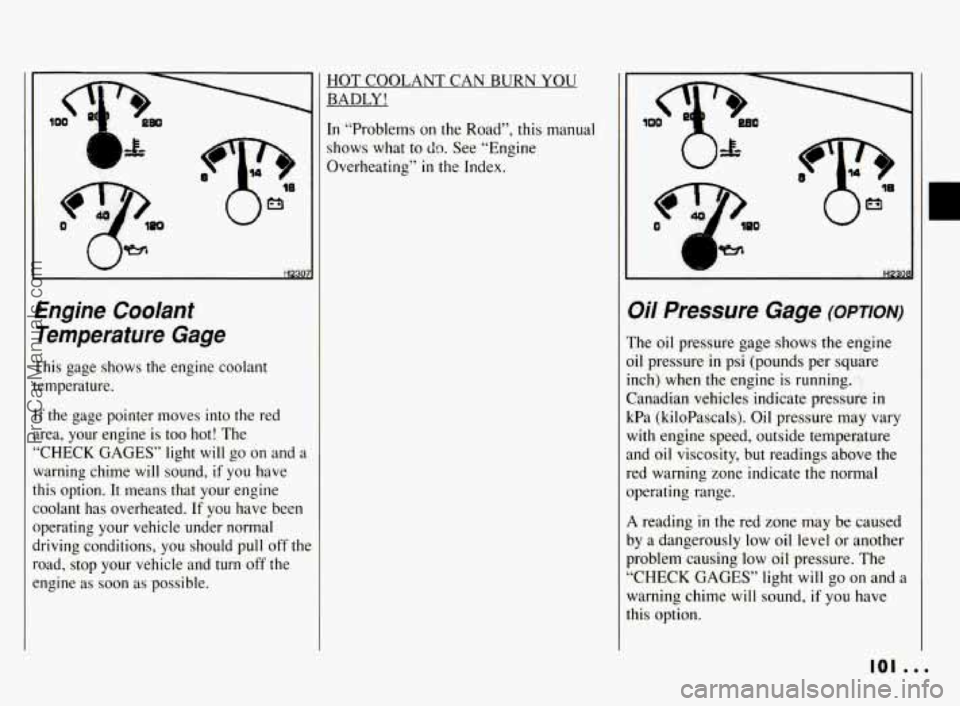
HOTCOOLANTCANBURNYOU BADLY!
In “Problems on the Road”, this manual
shows what to
do. See “Engine
Overheating”
in the Index.
H2a
Engine Coolant
Temperature Gage
This gage shows the engine coolant
temperature.
If the gage pointer moves into the red
area, your engine is too hot! The
“CHECK GAGES” light
will go on and a
warning chime will sound, if you have
this option.
It means that your engine
coolant has overheated.
If you have been
operating your vehicle under normal
driving conditions, you should pull off
thc
road, stop your vehicle and turn off the
engine
as soon as possible.
Oil Pressure Gage (omom-)
The oil pressure gage shows the engine
oil pressure
in psi (pounds per square
inch) when the engine is running.
Canadian vehicles indicate pressure
in
kPa (kiloPascals). Oil pressure may vary
with engine speed, outside temperature
and oil viscosity, but readings above the
red warning zone indicate the normal
operating range.
A reading in the red zone may be caused
by a dangerously
low oil level or another
problem causing low oil pressure. The
“CHECK GAGES” light
will go on and a
warning chime will sound,
if you have
this option.
101 ...
ProCarManuals.com
Page 207 of 290
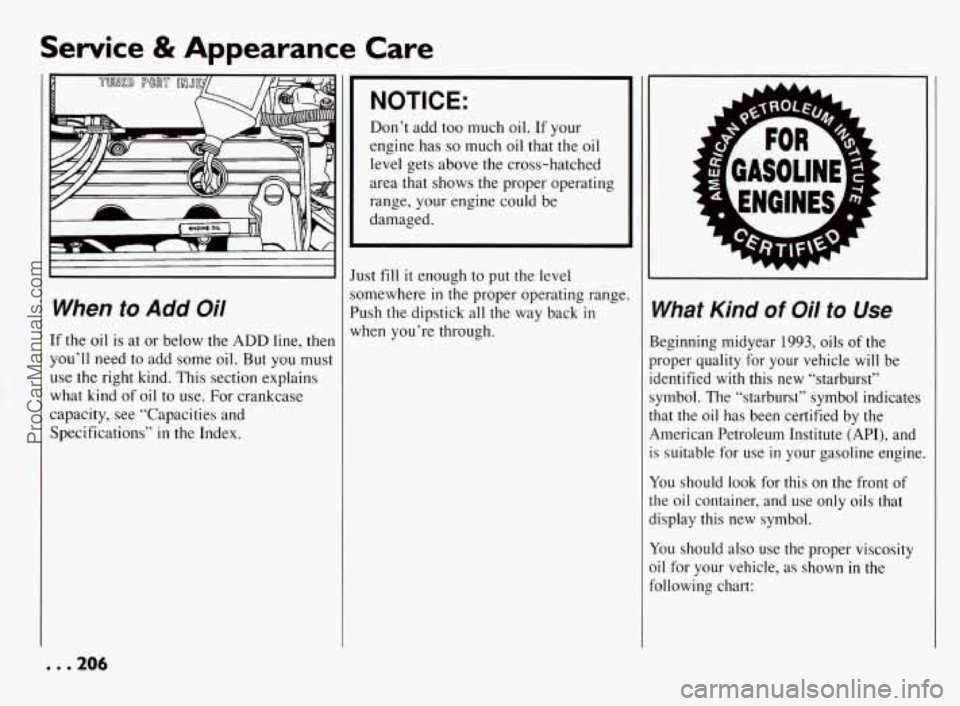
Service & Appearance Care
When to Add Oil
If the oil is at or below the ADD line, then
you’ll need to add some oil. But you must
use the right kind. This section explains
what kind of oil to
use. For crankcase
capacity,
see “Capacities and
Specifications” in the Index.
, . .206
NOTICE:
Don’t add too much oil. If your
engine has
so much oil that the oil
level gets above the cross-hatched
area that shows the proper operating
range, your engine could be
damaged.
Just fill it enough to put the level
somewhere in the proper operating range.
Push the dipstick all the way back in
when you’re through.
What Kind of Oil to Use
Beginning midyear 1993, oils of the
proper quality for
your vehicle will be
identified with this new “starburst”
symbol. The “starburst” symbol indicates
that the oil has been certified by the
American Petroleum Institute (API), and is suitable for use
in your gasoline engine.
You should look for this on the front of
the
oil container, and use only oils that
display this new symbol.
You should also use the proper viscosity
oil for your vehicle,
as shown in the
following chart:
ProCarManuals.com
Page 208 of 290
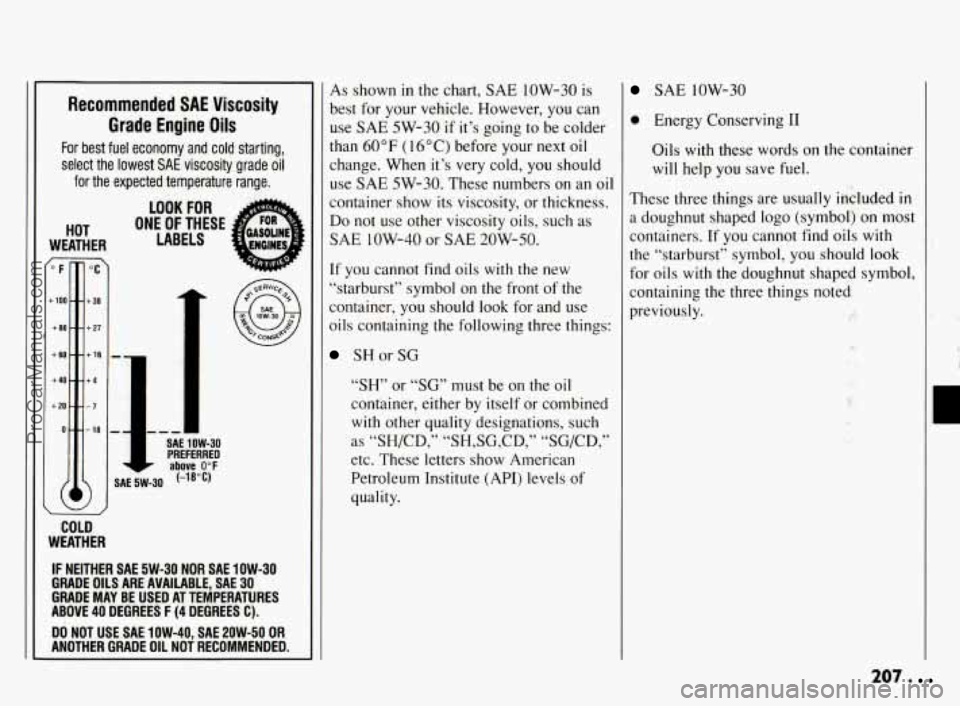
Recommended SAE Viscosity
Grade Engine Oils
For best fuel economy and cold starting,
select the lowest
SAE viscosity grade oil
for the expected temperature range.
LOOK FOR fi
HOT ONE OF THESE -. FOR ~
WEATHER LABELS
P c
-
-
SAE 1 OW-30 PREFERRED
SAE 5W-30
IF NEITHER SAE 5W-30 NOR SAE 1OW-30
GRADE OILS ARE AVAILABLE, SAE
30
GRADE MAY BE USED AT TEMPERATURES
ABOVE 40 DEGREES
F (4 DEGREES C).
ANOTHER GRADE OIL NOT RECOMMENDED.
DO
NOT USE
SAE 1OW-40, SAE 2OW-50 OR
As shown in the chart, SAE 1OW-30 is
best for your vehicle. However, you can
use SAE 5W-30
if it’s going to be colder
than 60°F (16°C) before your next oil
change. When it’s very cold, you should
use SAE 5W-30. These numbers on an oil
container show its viscosity, or thickness.
Do not use other viscosity oils, such as
SAE 1OW-40 or SAE
20W-50.
If you cannot find oils with the new
“starburst” symbol on the front of the
container, you should
look for and use
oils containing the following three things:
SHor SG
“SH” or “SG’ must be on the oil
container, either by itself or combined
with other quality designations, such
as “SH/CD,” “SH,SG,CD,” “SG/CD,”
etc. These letters
show American
Petroleum Institute (API) levels of
quality.
SAE low-30
0 Energy Conserving I1
Oils with these words on the container
will help you save fuel.
These three things are usually included in
a doughnut shaped logo (symbol) on most
containers. If you cannot find oils
with
the “starburst” symbol, you should look
for oils
with the doughnut shaped symbol,
containing the three things noted
previously.
C
207.
ProCarManuals.com
Page 255 of 290
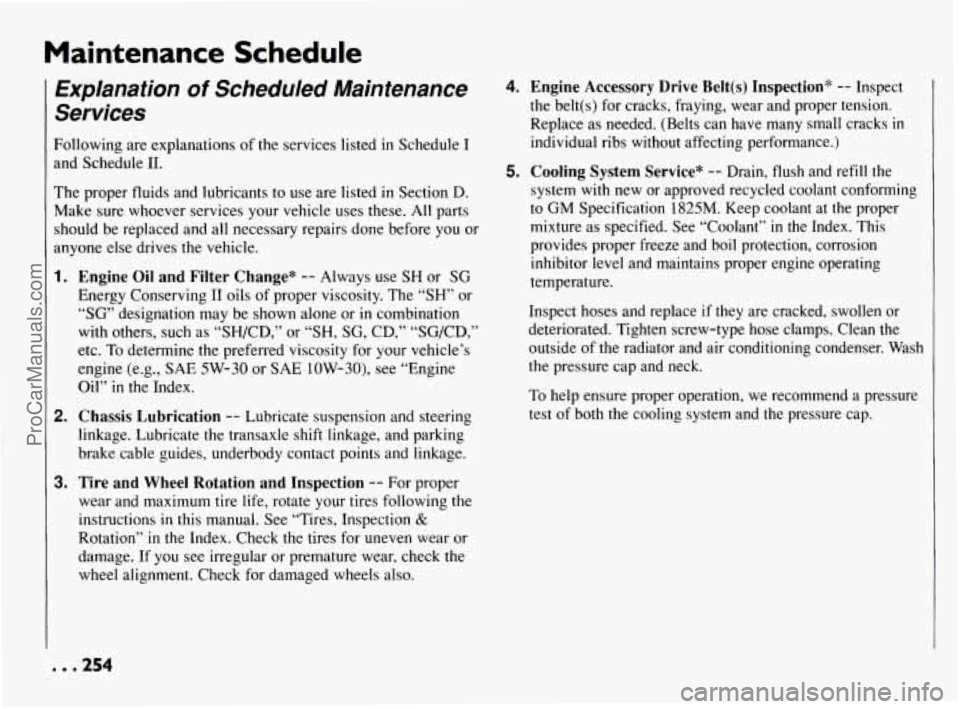
Maintenance Schedule
Explanation of Scheduled Maintenance
Services
Following are explanations of the services listed in Schedule I
and Schedule
11.
The proper fluids and lubricants to use are listed in Section D.
Make sure whoever services your vehicle uses these. All parts
should be replaced and all necessary repairs done before you or
anyone else drives the vehicle.
1. Engine Oil and Filter Change* -- Always use SH or SG
Energy Conserving I1 oils
of proper viscosity. The “SH” or
“SG” designation may be shown alone or in combination
with others, such as “SH/CD,” or “SH, SG, CD,” “SG/CD,”
etc. To determine the preferred viscosity for your vehicle’s
engine (e.g., SAE 5W-30 or SAE
10W-30), see “Engine
Oil”
in the Index.
2. Chassis Lubrication -- Lubricate suspension and steering
linkage. Lubricate the transaxle shift linkage, and parking
brake cable guides, underbody contact points and linkage.
3. Tire and Wheel Rotation and Inspection -- For proper
wear and maximum tire
life, rotate your tires following the
instructions in this manual. See “Tires, Inspection &
Rotation” in the Index. Check the tires for uneven wear or
damage. If
you see irregular or premature wear, check the
wheel alignment. Check for damaged wheels also.
4. Engine Accessory Drive Belt(s) Inspection* -- Inspect
the belt(s) for cracks, fraying, wear and proper tension.
Replace as needed. (Belts can have many small cracks
in
individual ribs without affecting performance.)
5. Cooling System Service* -- Drain, flush and refill the
system with new or approved recycled coolant conforming
to GM Specification 1825M. Keep coolant at the proper
mixture as specified. See “Coolant”
in the Index. This
provides proper freeze and boil protection, corrosion inhibitor level and maintains proper engine operating
temperature.
Inspect hoses and replace
if they are cracked, swollen or
deteriorated. Tighten screw-type hose clamps. Clean the
outside of the radiator and air conditioning condenser. Wash
the pressure cap and neck.
To help ensure proper operation, we recommend a pressure
test of both the cooling system and the pressure cap.
ProCarManuals.com
Page 262 of 290
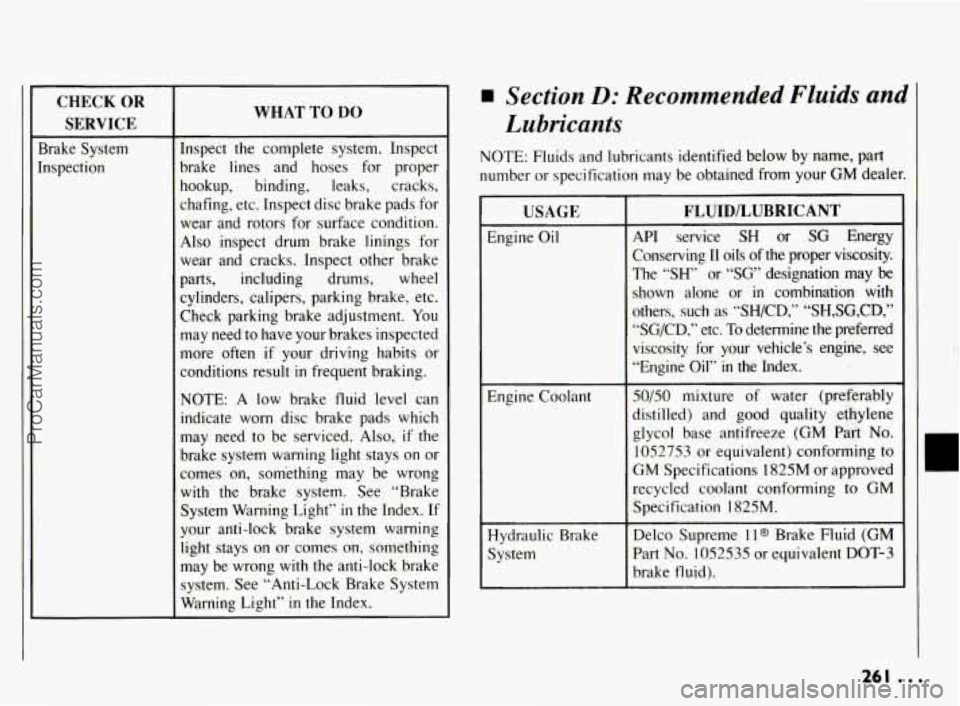
~~
~~ CHECK OR
SERVICE
Brake System
[nspection
WHAT TO DO
Inspect the complete system. Inspect
brake lines and hoses for proper
hookup, binding, leaks, cracks,
chafing, etc. Inspect disc brake pads for
wear and rotors for surface condition.
Also inspect drum brake linings for
wear and cracks. Inspect other brake
parts, including drums, wheel
cylinders, calipers, parking brake, etc.
Check parking brake adjustment. You
may need to have your brakes inspected
more often
if your driving habits or
conditions result
in frequent braking.
NOTE: A low brake fluid level can
indicate worn disc brake pads which
may need to be serviced.
Also, if the
brake system warning light stays on or
comes on, something may be wrong with the brake system. See “Brake
System Warning Light”
in the Index. If
your anti-lock brake system warning
light stays on or comes on, something
may be wrong with the anti-lock brake
system. See “Anti-Lock
Brake System
Warning Light”
in the Index.
Section D: Recommended Fluids and
Lubricants
NOTE: Fluids and lubricants identified below by name, part
number or specification may be obtained from your GM dealer.
USAGE
Engine Oil
Engine Coolant
Hydraulic Brake System
FLUID/LUBRICANT
API service SH or SG Energy
Conserving
I1 oils of the proper viscosity.
The
“SH’ or “SG’ designation may be
shown alone or in combination with
others, such as “SH/CD,” “SH,SG,CD,”
“SG/CD,” etc.
To determine the preferred
viscosity for your vehicle’s engine,
see
“Engine Oil” in the Index.
50/50 mixture of water (preferably
distilled) and good quality ethylene
glycol base antifreeze (GM Part
No.
1052753 or equivalent) conforming to
GM Specifications 1825M or approved
recycled coolant conforming
to GM
Specification 1825M.
Delco Supreme ll@ Brake Fluid (GM
Part
No. 1052535 or equivalent DOT-3
brake fluid).
261 ...
ProCarManuals.com